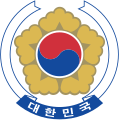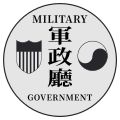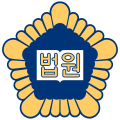Emblem of South Korea
- Machine translation, like DeepL or Google Translate, is a useful starting point for translations, but translators must revise errors as necessary and confirm that the translation is accurate, rather than simply copy-pasting machine-translated text into the English Wikipedia.
- Do not translate text that appears unreliable or low-quality. If possible, verify the text with references provided in the foreign-language article.
- You must provide copyright attribution in the edit summary accompanying your translation by providing an interlanguage link to the source of your translation. A model attribution edit summary is
Content in this edit is translated from the existing Korean Wikipedia article at [[:ko:대한민국의 국장]]; see its history for attribution. - You may also add the template
{{Translated|ko|대한민국의 국장}}to the talk page. - For more guidance, see Wikipedia:Translation.
| National Emblem of the Republic of Korea 대한민국의 국장 | |
|---|---|
 | |
| Armiger |  South Korea South Korea |
| Adopted | 10 December 1963; 60 years ago (1963-12-10) |
| Motto | 대한민국 (Republic of Korea) |
 |
| Part of a series on the |
| Culture of Korea |
|---|
| Society |
|
| Arts and literature |
| Other |
| Symbols |
|
|
The National Emblem of the Republic of Korea (Korean: 대한민국의 국장; Hanja: 大韓民國의 國章), also officially referred as Naramunjang (Korean: 나라문장; Hanja: 나라紋章, lit. 'State emblem'), consists of the taegeuk symbol present on the South Korean national flag surrounded by five stylized petals and a ribbon bearing the inscription of the official Korean name of the country (Daehan Minguk), in Korean characters. The Taegeuk represents peace and harmony. The five petals all have meaning and are related to South Korea's national flower, the Hibiscus syriacus, or Rose of Sharon (Korean: 무궁화; Hanja: 無窮花, mugunghwa).
The emblem was announced on 10 December 1963.[1][2][3][4] The flower and taegeuk symbols are generally considered by South Koreans to be symbolic of the "Korean ethnos" (Korean: 한민족).[3]

Historical national emblems
-
 Emblem of the Provisional Government of the Republic of Korea (1919–1948)
Emblem of the Provisional Government of the Republic of Korea (1919–1948) -
 Emblem of South Korea (1948–1963)
Emblem of South Korea (1948–1963) -
 Emblem of South Korea (1963–1984)
Emblem of South Korea (1963–1984) -
 Emblem of South Korea (1984–1997)
Emblem of South Korea (1984–1997) -
 Emblem of South Korea (1997–2011)
Emblem of South Korea (1997–2011) -
 Emblem of South Korea (2011–present)
Emblem of South Korea (2011–present)
Other national emblems
-
 Seal of the United States Army Military Government in Korea (1945–1948)
Seal of the United States Army Military Government in Korea (1945–1948) -
 Emblem of the People's Republic of Korea (1945–1946)
Emblem of the People's Republic of Korea (1945–1946)
Other emblems
Executive
-
 Emblem of the National Government (1949–2016)
Emblem of the National Government (1949–2016) -
 Emblem of the National Government, a stylized Taegeuk (2016–present)
Emblem of the National Government, a stylized Taegeuk (2016–present) -

-
 Seal of the Office of the President, with two phoenixes facing each other over the office building and a rose of Sharon
Seal of the Office of the President, with two phoenixes facing each other over the office building and a rose of Sharon -
 Emblem of the Prime Minister: A rose of Sharon enclosed by another
Emblem of the Prime Minister: A rose of Sharon enclosed by another
Legislative
-
 Emblem of the National Assembly (1948-2014)
Emblem of the National Assembly (1948-2014) -
 Emblem of the National Assembly: The word "국회" meaning 'National Assembly' (gukhoe; 國會 in Hanja) appears in Korean characters in the center of a rose of Sharon
Emblem of the National Assembly: The word "국회" meaning 'National Assembly' (gukhoe; 國會 in Hanja) appears in Korean characters in the center of a rose of Sharon
Judicial
-
 Emblem of South Korean Court
Emblem of South Korean Court -
 Emblem of the Constitutional Court of Korea (1988–2017)
Emblem of the Constitutional Court of Korea (1988–2017) -
 Emblem of the Constitutional Court of Korea (2017–present)
Emblem of the Constitutional Court of Korea (2017–present)
Gallery
-

-
 Emblem on South Korean Honorary Consul in Gent, Belgium
Emblem on South Korean Honorary Consul in Gent, Belgium
See also
- Seal of South Korea
- Flag of South Korea
- Emblem of North Korea
- Imperial Seal of Korea, uses plum blossom instead
- Taegeuk
References
- ^ Ministry of the Interior of the Republic of Korea (2017). National Symbols of the Republic of Korea: Uniting People and Elevating National Pride. Seoul: Ministry of the Interior of the Republic of Korea. pp. 10–11. Archived from the original on 2017-08-06. Retrieved 6 August 2017.
- ^ "우리나라 국가상징> 나라문장".
- ^ a b Myers, Brian Reynolds (2011). "North Korea's state-loyalty advantage". Free Online Library. Archived from the original on 20 May 2018. Retrieved 20 May 2018.
The state emblem (adopted in 1963) is a taegeuk symbol on a rose of Sharon--another purely racial symbol.
- ^ 관보 [Official Gazette]. Government of the Republic of Korea. 10 December 1963. pp. 25–26. Retrieved 5 July 2024.
External links
- The National Emblem - Ministry of Interior and Safety
































